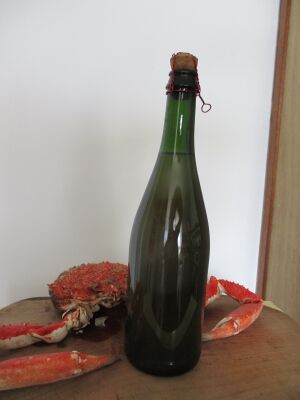Cider 2019
<<<Back to crowdfunding page>>>
Here you can find short overview about the cider as a product, season 2019. The cider is made from untreated apples, harvested by hand in smaller orchards in the Vale de Saire region. This autumn was particularly rainy. The apples are crashed and pressed on "presse à paquets" using local service provider. The juice/moût is than fermented with native yeast present both on the apples and in the cave. There is no temperature control. The specific density, sugar content of the juice was around standard for the region this year, around 1050 (2018 was very high even around 1075). The weather was quite warm, temperature above the optimal 8°C for cider fermentation with minimum of cold periods which would allow for soutirage/racking. For some of the batches I did minimal filtration through cardboard paper filters. I do not use any chemicals during or after the fermentation process. Before the bottling I've done the yeast count and based on that I filter bit more or directly bottle the cider. The fermentation in the bottle, prise de mousse naturelle, takes around four months, preferably at temperatures below 10°C. The cider 2019 is ready for sale since September 2020. At the end the secondary fermentation went very well, so all the main three batches, assemblage 1 (brut unfiltered), assemblage 2 (extra-brut slightly filtered) and assemblage 3 (brut slightly filtered) stay nicely in bottles after opening. When you get your cider please keep in mind, that it is life product, it is very important. There are still active yeast and bacteria cells in the product therefore you should keep it stored at temperature under 10°C, definitely under 15°C. It is very important to pay attention to this with natural ciders prepared like this, especially when they are still young. After a year in bottle or year and half the product is much more stable and than storing at higher temperatures, like 20°C is not so dangerous.
Now bit about the flavour. This is a typical Cotentin style cider (however it is not AOP, at least not yet). What does that means? Well our region is basically the most astringent and bitter cider region in France. The apples are very high on phenolic compounds therefore you can see it in a colour, which can go as deep as "amber", sometimes you can smell it, it's fragrance may be stronger because of the phenolic compounds which may be responsible for special aromas too and as mentioned you can profit from a complex bitter and astringent flavour. The cider is bit opaque because it is either not filtered at all or filtered just very lightly compared to standard commercial products. Also and importantly it has a deposit. From the point of view of effervescence the sparkling is good and because of the prise de mousse naturelle the bubbles are very small and they last for a long time, even few days when cider is opened and not closed. For the ones who know my ciders a bit already, the millésime 2019 is more like 2017, so quite light, for brut alcohol around 5-5.5%. It is less strong by flavour and astringency/bitterness than 2018 which was very high on sugars (around 6% alc or bit over) and high on bitter apples. Personally I'm really happy with the results of the 2019 because it is much more easy to drink when you are thirsty.
I've made also some micro-cuves.
- cidre traditionnelle (traditional cider) - apples crashed by old style broyer using an electric engine, juice made on an old style press "à cliquets" or "à clavettes", pressed by manual force. The cider got bit too fizzy in the bottles so we had to decapsule it, the final flavour is good, between brut and extra-brut. There is likely to be "casse ferrique" which means that the iron which is likely to be present in the cider from the crahser will react with oxygen and the cider may eventually change colour, darken. It has no effect on flavour, it is legally fine and if it happens it will probably be over night if the cider is not drunk.
- cidre gingembre (ginger cider) - cider with cold infusion of ginger, nice and spicy.
- cidre fleur de sureau (elderflower cider) - cider flavoured with home made elderflower syrup fermented to complete dryness (the syrup and cider are uncertified but bio).
- cidre mielé (honey cider) - cider with addition of honey, had to be recapsuled because of the higher effervescence, flavour is nice you can definitely taste the hint of honey in it, it is also a bit stronger on alcohol, by the amount of the sugars brut. The honey was usual store honey, not organic or local.
- cidre sarrasin (buckwheat cider) - made with a maceration of crashed grilled buckwheat fermented to complete dryness, sparkling (the sarrasin was certified bio).
- cidre calvados (calvados cider) - I used tonneau (barrel) after calvados and let the cider sit in it for month or so and bottled it after. Strong woody and calvados flavour and non sparkling, the alcohol level is bit elevated.
